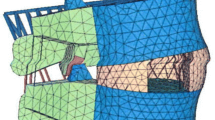Abstract.
The authors present an investigation into the biomechanical functioning of a new titanium implant for vertebral body replacement (Synex). Possible indications are fractures and/or dislocations with damage of the anterior column, post-traumatic kyphosis and tumors of the thoracolumbar spine. The construction must be supplemented by a stabilizing posterior or anterior implant. For best fit and contact with adjacent end-plates, Synex is distractable in situ. We performed comparative compression tests with Synex and MOSS ("Harms mesh cage") on human cadaveric specimens of intact vertebrae (L1). The aim of the study was to measure the compressive strength of the vertebral body end-plate in uniaxial loading via both implants to exclude collapse of Synex in vivo. Twelve human cadaveric specimens of intact vertebrae (L1) were divided into two identical groups (matched pairs) according to bone mineral density (BMD), determined using dual-energy quantitative computed tomography (DE-QCT). The specimens were loaded with an axial compression force at a constant speed of 5 mm/min to failure, and the displacement was recorded with a continuous load-displacement curve. The mean ultimate compression force (F max) showed a tendency towards a higher reading for Synex: 3396 N versus 2719 N (non-significant). The displacement until F max was 2.9 mm in the Synex group, which was half as far as in the MOSS group (5.8 mm). The difference was significant (P<0.001). The compression force was twice as high, and significantly (P<0.05) higher with Synex at displacements of 1 mm, 1.5 mm and 2 mm. A significant (P<0.001) correlation (R=0.89) between F max and BMD was found. Synex was found to be at least comparable to MOSS concerning the compressive performance at the vertebral end-plate. A possible consequence of the significantly higher mean compression forces between 1 and 2 mm displacement might be decreased collapse of the implant into the vertebral body in vivo.
Similar content being viewed by others
Author information
Authors and Affiliations
Additional information
Electronic Publication
Rights and permissions
About this article
Cite this article
Knop, C., Lange, U., Bastian, L. et al. Biomechanical compression tests with a new implant for thoracolumbar vertebral body replacement. Eur Spine J 10, 30–37 (2001). https://doi.org/10.1007/s005860000211
Received:
Revised:
Accepted:
Issue Date:
DOI: https://doi.org/10.1007/s005860000211




